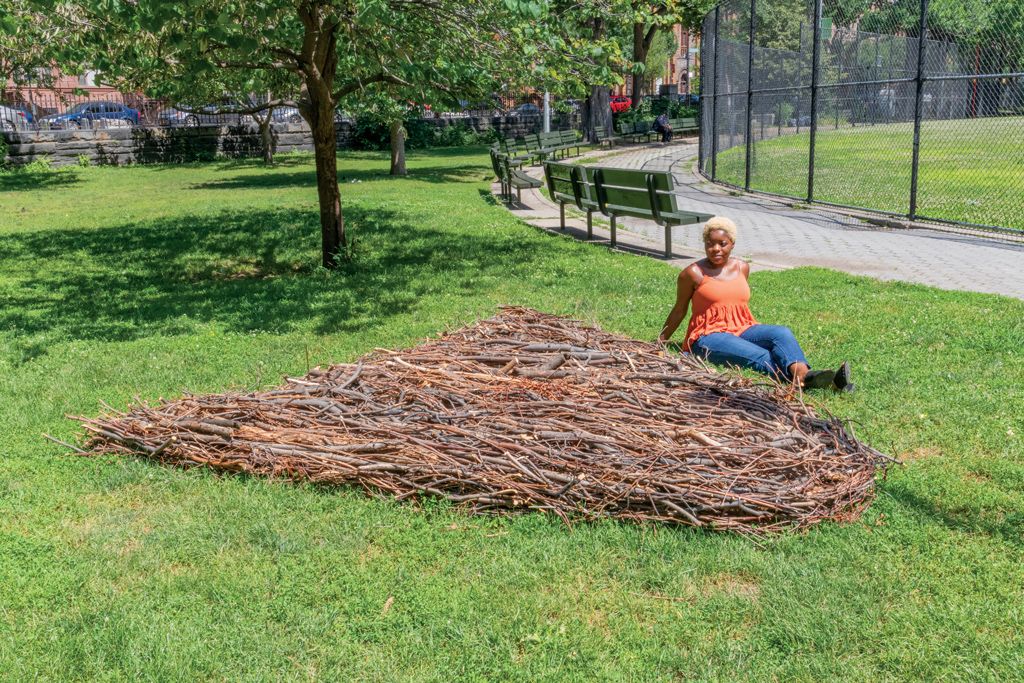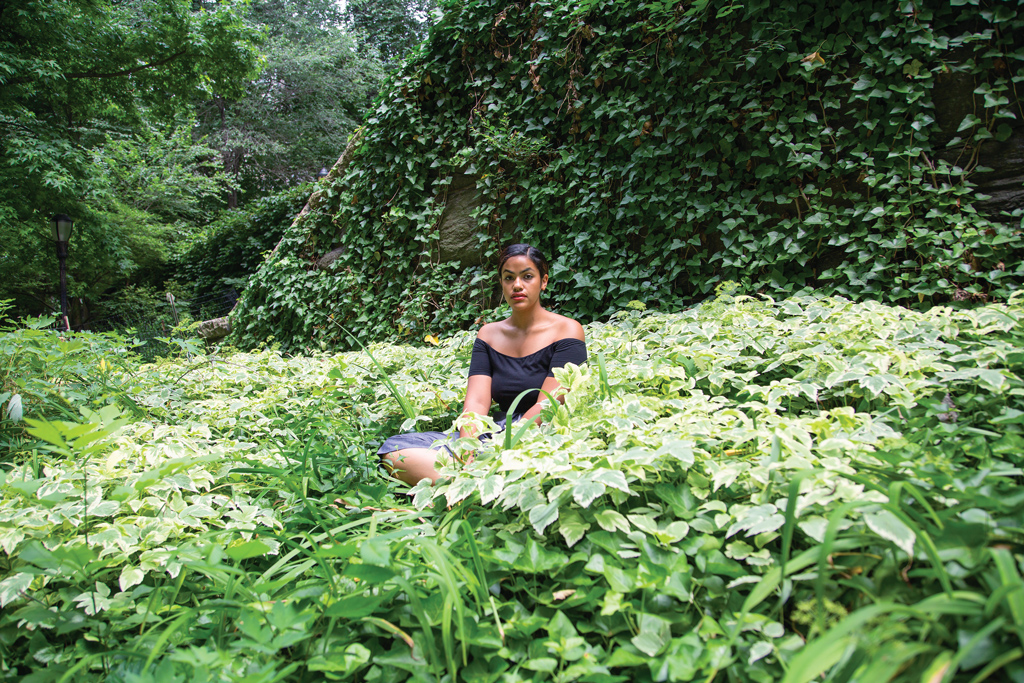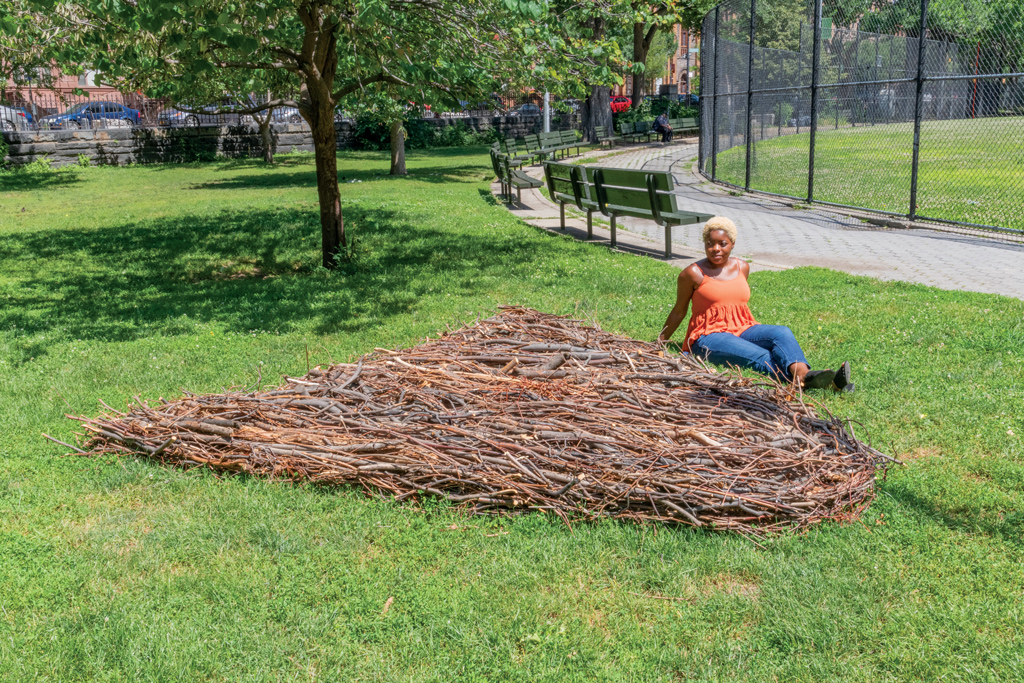[ad_1]

Maren Hassinger, Monuments, 2018, eight site-specific sculptures in Marcus Garvey Park, Harlem, installation view.
ADAM REICH/COURTESY THE ARTIST AND SUSAN INGLETT GALLERY
On a quiet weekday afternoon in Harlem, a young girl and an older woman sit on a bench near the baseball field in Marcus Garvey Park staring quizzically at a large sculpture comprising tree branches, wire, and rusted fence parts. With a curiosity tempered by caution, the girl rises from the bench and slowly begins to approach the sculpture, glancing backward at the woman, perhaps her grandmother, as if asking for permission, before finally reaching the form. Standing at the base of the sculpture, she leans down to touch the branches and as she does so, she smiles. Without speaking, she stands up and walks back to the bench, satisfied with her moment of wonder. However, on this particular day, the girl seemed to be alone in her explicit fascination as I watched people from various locations in the park, hoping to glimpse interactions with Maren Hassinger’s creations.
The series, “Monuments,” is a yearlong installation of eight site-specific pieces that respond to the park’s landscape and, in turn, invite the public to share in the artist’s meditation; it is part of the “inHarlem” program presented by the Studio Museum in Harlem. “Monuments,” which is on view through June 10, 2019, fits squarely within Hassinger’s legendary oeuvre. Having long worked at the intersection of abstraction, performance art, sculpture, and fiber arts, she probes the boundaries of our relationship to the natural world. The sculptures bear her signature elements of material blending and manipulation, in some instances alluding to or taking on the shape of sites within the park itself. A circular form rests near the entrance to the public swimming pool. An immense woven cube form mimics the chess tabletops nearby. Generous in scale, they exist as elegant, understated additions to the park’s landscape, built by Hassinger in collaboration with participants from the museum’s Expanding the Walls high school program and Teen Leadership Council.
These pieces’ very lack of spectacle is part of the intended effect. I returned to the park on a busy Harlem weekend to find that, amid a flurry of picnics and pool visits, the sculptures faded into the background. Hassinger’s forms cultivate a space of introspection and reflection: the natural world is informed by our actions even as we are informed by changes in its architecture. In what ways are we entangled with our environs, Hassinger asks. What do we do with these connections and the memories of these connections?

Joan Jonas, Moving Off the Land. Ocean — Sketches and Notes, 2018, performance view. Danspace Project.
IAN DOUGLAS/COURTESY THE ARTIST AND GAVIN BROWN’S ENTERPRISE, NEW YORK AND ROME
Such an inquiry is also embodied in a recent performance by Joan Jonas that calls attention to the ocean as a site through which to contemplate a destiny we share with the ecological sphere. Moving Off the Land. Ocean — Sketches and Notes had its U.S. premiere in June at Danspace Project in New York after debuting at Tate Modern in London this past May. The performance brings together video, poetry, movement, and sound in a non-linear fashion as Jonas and her collaborators traverse a terrain of mythology and poetry, moving us through the artist’s own questioning and exploration of the sea.
Jonas draws attention to the lives and conditions of sea creatures like the octopus by making poetic use of her own writings as well as those of Emily Dickinson, Herman Melville, and Sy Montgomery, which she reads aloud. As she reads, drawings of sea life, ocean footage, and scenes from previously recorded performances appear on a large screen. At times, there is video of Jonas herself in the water, further adding to the performance’s ethereal nature: Do we ask new questions of the natural world as we age? (What curiosities await that young girl in Harlem, for example?) In other instances, Jonas positioned herself and the body of her collaborator such that they collectively became the screen for these projections, to mesmerizing effect.
Ikue Mori’s score was one of the performance’s most captivating elements. It was this music that truly conveyed Jonas’s reflections to the audience, and strengthened her piece. Like Hassinger, Jonas believes that the fate of human beings is intertwined with that of plants, animals, and the environment at large; unlike Hassinger, she is moved to lecture on the point: Moving Off the Land closed with Jonas’s return to the lectern to admonish the audience to be mindful of the harm many of our activities can cause. It is a justifiable and necessary urgency, even if it did slightly weaken the performance’s poetic conclusion.

Huma Bhabha, We Come in Peace, 2018, installation view. The Metropolitan Museum of Art.
HYLA SKOPITZ, FOR THE METROPOLITAN MUSEUM OF ART/©HUMA BHABHA/COURTESY THE ARTIST AND SALON 94
Huma Bhabha is acutely aware of this harm; for her, the chaos has already materialized, time and time again. We Come in Peace, Bhabha’s commission for the Metropolitan Museum of Art’s rooftop terrace (on view through October 28) takes its title from the most memorable line in the 1951 sci-fi flick, The Day the Earth Stood Still. The installation comprises two pieces: A 12-foot-tall standing figure—whose surface is scratched and gouged, and whose head has four faces—and another figure 18 feet long lying prostrate before it, covered in a black plastic tarp. The second piece is titled Benaam, an Urdu word meaning “unnamed.”
There is nothing subtle about these creatures. Bhabha sculpted them in cork and Styrofoam before casting them in bronze, and the marks they bear from this process further punctuate their magnanimity. Commanding in presence, it is as if the sculptures are beckoning to one another. Is this a meeting of reconciliation or deference? The work’s title suggests the former even as the setting of the installation itself points to the latter. Bhabha is clear about her lack of interest in spelling it out for us with a curatorial declaration, preferring to simply “let the drama unfold,” as she told the Met’s Assistant Curator of South Asian Art, Shanay Jhaveri, in a video interview recorded by the museum.
Human systems often fail us; much damage has been done, the piece seems to be saying. What’s more, the catastrophic consequences of these systems is not always evenly shared: war, climate change, poverty. Is there hope for restoration? And if so, what are the terms? It is an interrogation as daunting in its nature as the sculptures themselves. And in spite of its placement on the roof of one of the world’s busiest cultural institutions, it is still quite possible to locate a moment of stillness, of contemplation in service to this inquiry: as many people taking selfies as I saw during my visits, I saw an equal number of visitors, if not more, standing before the figures in pensive solitude. In fact, it is as if Bhabha expected that.

Naima Green, Jareline, Riverside Park, from the series “Jewels from the Hinterland,” 2015. Arsenal Gallery.
COURTESY THE ARTIST
Tucked away in the Arsenal Gallery in Central Park this summer, Naima Green’s “A Collective Utterance” also took up the environment, in this case as a method for questioning the politics of place. Turning her attention to presumptions about who belongs in public spaces and how those presumptions are derived, Green has created a portraiture series that considers the natural as a site of rest while also rejecting myths of decay that have long been unfairly associated with black and other communities of color in urban settings. The exhibition pulled largely from photographs taken as part of Green’s “Jewels from the Hinterland” (2013–ongoing) project, printed in varying sizes. (Full disclosure: I sat for a portrait by Green in 2015 that is included in the exhibition.)
Captured primarily in various New York City parks, Green’s sitters convey an air of assuredness. In one image, you can glimpse a young black woman wearing a floral tunic and a soft smirk, as though she is daring you to tell her she doesn’t belong. In another photograph, a woman sits with her eyes closed, positioned toward the sun with a regal sensibility.
With an undergraduate degree in urban studies, Green well understands the urban planning policies that, over time, have resulted in the structural inequities that inform access to such landscapes. Moreover, she is deeply aware of the history of imaging that informs stereotypical perceptions of urban communities of color. Focusing thus far on cityscapes, her project is both a corrective for how people of color have been portrayed in a specific context and an acknowledgment of what some of us have long known: the tender reprieves offered by nature’s fullness are endless, and available to us all.
A version of this story originally appeared in the Fall 2018 issue of ARTnews on page 38 under the title “Around New York.”
[ad_2]
Source link

